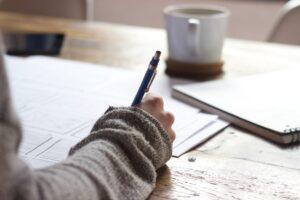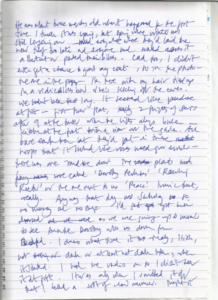Every Picture Tells a Story: 'Creative Interactions'

An experiment in creative learning
On a grey Saturday morning in March 2020, as the UK teetered on the brink of the first lockdown, a small group of students gathered at the Open University campus in Milton Keynes to take part in an experiment. Half of the group were studying Creative Writing, and the other half were students of Art History.
The experiment – a project called ‘Creative Interactions’ – had been dreamt up by me (Dr Heather Richardson, Creative Writing) and Art Historian Dr Clare Taylor, ably assisted by two of our Associate Lecturer colleagues, Dr Helen Mosby and Dr Diana Newall. The plan was to find out what happens when the teaching techniques of the two disciplines are swapped around. Luckily for us the Open University has an extensive art collection, much of which is on display around the campus. This meant we were able to come face to face with artworks from all around the world over the course of the day.
Ekphrasis and visual analysis
Ekphrasis is a familiar phrase to many people studying Creative Writing and comes from the ancient Greek words for describing or speaking out. Put simply, ekphrasis is writing that describes a piece of visual art, and it’s cropped up in literature for hundreds of years – think of Keats’ ‘Ode on a Grecian Urn’, for example. Every Creative Writing tutor has some ekphrastic exercises in their toolbox, where we show the students an image and encourage them to let their imaginations off the leash. What we’re hoping for is an emotional response – a gut reaction – that will lead students to a creative response in the form of a story or poem inspired by what they see.
Art History tutors and students on the other hand engage with artworks in a very different way. Their first step when they encounter an artwork is to carry out a visual analysis, considering issues like composition, colour, and the materials used. Another important element is the historical or social context in which the work was produced. It’s all very different from the way Creative Writing students make use of visual art.
Of course, we wanted our student volunteers to get practical benefits from the workshop that would help them on their modules, so for the first part of the day they worked with the tutor from their own discipline and engaged with several pieces of art in the usual way for their subject. It was then that the experiment really began as the two groups swapped, with the Art History students working with the Creative Writing tutor, and vice-versa for the Creative Writing students.
Imaginative adventures
I sat in with the Art History students as Creative Writing tutor Helen Mosby led them through a series of activities while looking at David Tindle’s Mural Panel C. At first glance this looks to me like a lovely image of a summer day, viewed through partially open French windows. Helen drew our attention to the old-fashioned telephone, receiver off the hook, sitting outside the French windows, and we tried to imagine the circumstances behind it. Had someone been trying to make a secret phone call, out of earshot of anyone else in the house? Or had some emergency occurred which had led them to throw the receiver down and run off?
The Art History students pointed out the areas of shadow amongst the trees on the right-hand side of the painting, and the misty effect caused by the barely-visible voile curtains, and with our creative writing hats on we wondered if these suggested a darker or unsettling aspect to the stories we were inventing.
For the final part of the workshop we all came together to consider a triptych – an artwork made up of three pieces – with input and discussion from both disciplines, followed by a creative writing session.
 Insights
Insights
At the end of the workshop we asked the students what they had learnt. Unsurprisingly, both disciplines said they felt better able to carry out a visual and formal analysis of artworks. One Creative Writing student said, ‘Looking at artwork from an art historian’s perspective would lead to different stimuli’, while another said they had learnt ‘How to interpret art as a medium with a purpose’. The Art History students commented on the creative writing activities, with one saying, ‘Spontaneous creative writing is hard!’ while another acknowledged the benefits of writing without hesitation, stating emphatically, ‘I can write!’
The students reflected on how the workshop had enhanced their appreciation of both their ‘home’ and ‘other’ discipline, with Creative Writing students feeling that analysing the artworks in detail would help them with their descriptive writing, while the Art History students concluded that thinking of an artwork in terms of narrative or subject matter would add a new dimension to their interpretation.
What next?
After the workshop Clare, Diana, Helen and I agreed that the experiment had proved the value to students of a creative interaction between their disciplines. Our next step will be to roll out a virtual version of the workshop. Going online isn’t just about dealing with the ever-changing Covid-19 regulations, but also a way to ensure that more students get the opportunity to participate – not just those who live within travelling distance from Milton Keynes. And we plan to talk about ‘Creative Interactions’ at conferences and staff development events for Creative Writing and Art History tutors. Exciting things happen when two disciplines work together, and we’re going to make sure that story gets told.
Author:
Heather Richardson, Senior Lecturer, Staff Tutor & Deputy Director FASSTEST
